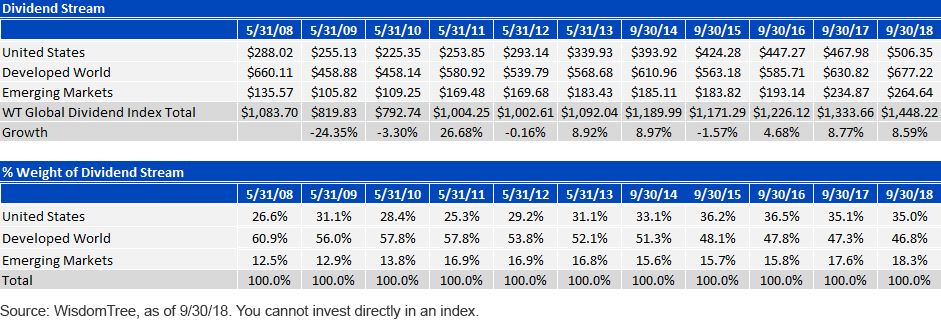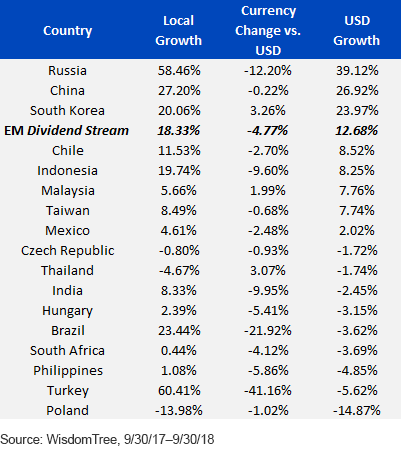Global Dividend Stream: Where We Saw Growth in 2018



Each year, we monitor the global Dividend Stream® for growth, so that we can refresh the weights of the underlying constituent companies in various WisdomTree Indexes.
This year, the global Dividend Stream reached another new high, and all regional markets reached new highs as well. The global Dividend Stream is measured in U.S. dollars, so the dollar’s strength over the past year slightly lowered growth rates when compared to local growth. The global Dividend Stream was able to grow at 8.59% over the most recent one-year period in U.S. dollar terms and approximately 11.06% in local currency terms.
To calculate the global Dividend Stream, we start with the 5,900-plus investable dividend payers in the WisdomTree Global Dividend Index. We then take the dividends per share for each company and multiply them by the company’s shares outstanding. The table below aggregates the Dividend Streams of each company by their respective region and shows a percentage breakdown by region.
Figure 1: Global Dividend Stream

Focus on Emerging Markets
One of the major regions that are rebalanced at this time of year is the emerging markets, and many clients want to know how dividends have grown across the various emerging market countries. The table below highlights the growth by country, which can be influenced by new payers, or by existing payers increasing their dollar dividend payments.
Figure 2: Emerging Market Dividend Growth by Country

- Russia: Known for its large landmass and plethora of natural resources, Russia’s energy and materials companies delivered strong dividend growth on the backs of improving earnings. Energy company Rosneft more than doubled its dividend per share year over year, an increase of over $2 billion. Even though energy giant Gazprom kept its dividend constant and Lukoil only raised its dividend modestly, other companies like Tatneft and MMC Norilsk Nickel contributed to the country’s dividend growth. Sberbank, a large financial company, also contributed substantially to the country’s growth with a 100% increase in its annual dividend.
- China: Large increases from energy companies also benefited China, with China Petroleum & Chemical Corp and CNOOC adding around $1 billion each to the stream. One of China’s largest dividend payers, China Mobile, also contributed an over $1-billion increase to the Dividend Stream. We note with interest that, in aggregate, the A-share market’s Dividend Stream is even larger. While not included above, we will write about the size of the dividend market, as well as the new additions in our emerging market Indexes, in future blog posts.
- South Korea: As the largest company by market cap in South Korea, and also its largest dividend payer, Samsung has significant influence on the growth of the country’s Dividend Stream. In October 2017, Samsung announced it was committed to paying out over 9.6 trillion won in dividends (approximately $8.5 billion) for each of fiscal years 2018 to 2020. So far this year, the company seems to be on pace, which has increased its year-over-year amount.
Understanding the source of dividend growth, while important, is just one part of a rules-based, relative-value process. To determine where the value really shines, we must consider this fundamental growth in relation to changes in price. In upcoming blog posts we will look at the various indexes using this dividend information in their weightings and discuss any changes for this year’s newly reconstituted indexes.



